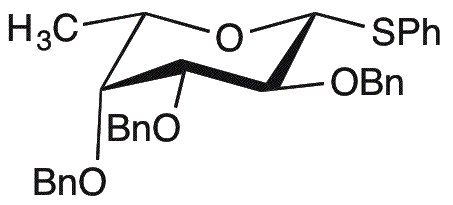Phenyl 2,3,4-tri-O-benzyl-1-thio-b-L-fucopyranoside is widely utilized in research focused on:
- Synthetic Chemistry: This compound serves as a versatile building block for synthesizing complex carbohydrates and glycosides, facilitating the development of new pharmaceutical agents.
- Glycobiology: It plays a crucial role in studying glycan structures and functions, helping researchers understand cell signaling and immune responses.
- Drug Development: The compound is used in the design of glycosylated drugs, which can enhance bioavailability and target specificity, making treatments more effective.
- Bioconjugation: It is employed in attaching sugars to proteins or other biomolecules, improving their stability and activity in therapeutic applications.
- Analytical Chemistry: This chemical aids in the development of analytical methods for detecting and quantifying carbohydrates in various samples, supporting quality control in food and pharmaceutical industries.
General Information
Properties
Safety and Regulations
Applications
Phenyl 2,3,4-tri-O-benzyl-1-thio-b-L-fucopyranoside is widely utilized in research focused on:
- Synthetic Chemistry: This compound serves as a versatile building block for synthesizing complex carbohydrates and glycosides, facilitating the development of new pharmaceutical agents.
- Glycobiology: It plays a crucial role in studying glycan structures and functions, helping researchers understand cell signaling and immune responses.
- Drug Development: The compound is used in the design of glycosylated drugs, which can enhance bioavailability and target specificity, making treatments more effective.
- Bioconjugation: It is employed in attaching sugars to proteins or other biomolecules, improving their stability and activity in therapeutic applications.
- Analytical Chemistry: This chemical aids in the development of analytical methods for detecting and quantifying carbohydrates in various samples, supporting quality control in food and pharmaceutical industries.
Documents
Safety Data Sheets (SDS)
The SDS provides comprehensive safety information on handling, storage, and disposal of the product.
Product Specification (PS)
The PS provides a comprehensive breakdown of the product’s properties, including chemical composition, physical state, purity, and storage requirements. It also details acceptable quality ranges and the product's intended applications.
Certificates of Analysis (COA)
Search for Certificates of Analysis (COA) by entering the products Lot Number. Lot and Batch Numbers can be found on a product’s label following the words ‘Lot’ or ‘Batch’.
Numéro de catalogue
Numéro de lot/série
Certificates Of Origin (COO)
This COO confirms the country where the product was manufactured, and also details the materials and components used in it and whether it is derived from natural, synthetic, or other specific sources. This certificate may be required for customs, trade, and regulatory compliance.
Numéro de catalogue
Numéro de lot/série
Safety Data Sheets (SDS)
The SDS provides comprehensive safety information on handling, storage, and disposal of the product.
DownloadProduct Specification (PS)
The PS provides a comprehensive breakdown of the product’s properties, including chemical composition, physical state, purity, and storage requirements. It also details acceptable quality ranges and the product's intended applications.
DownloadCertificates of Analysis (COA)
Search for Certificates of Analysis (COA) by entering the products Lot Number. Lot and Batch Numbers can be found on a product’s label following the words ‘Lot’ or ‘Batch’.
Numéro de catalogue
Numéro de lot/série
Certificates Of Origin (COO)
This COO confirms the country where the product was manufactured, and also details the materials and components used in it and whether it is derived from natural, synthetic, or other specific sources. This certificate may be required for customs, trade, and regulatory compliance.


